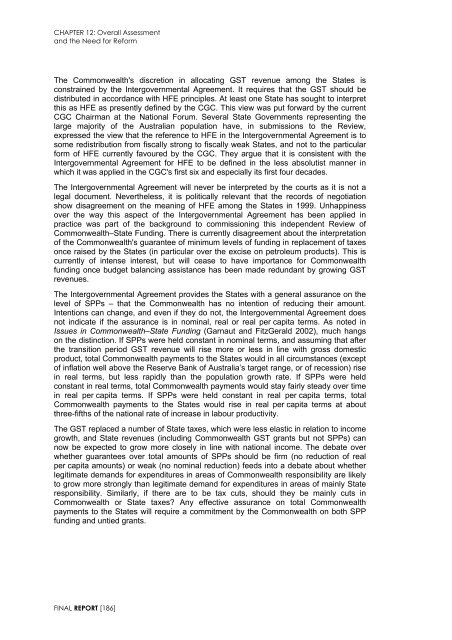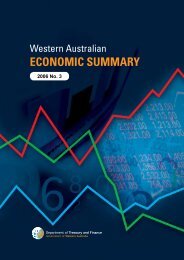Garnaut Fitzgerald Review of Commonwealth-State Funding
Garnaut Fitzgerald Review of Commonwealth-State Funding
Garnaut Fitzgerald Review of Commonwealth-State Funding
Create successful ePaper yourself
Turn your PDF publications into a flip-book with our unique Google optimized e-Paper software.
CHAPTER 12: Overall Assessment<br />
and the Need for Reform<br />
The <strong>Commonwealth</strong>'s discretion in allocating GST revenue among the <strong>State</strong>s is<br />
constrained by the Intergovernmental Agreement. It requires that the GST should be<br />
distributed in accordance with HFE principles. At least one <strong>State</strong> has sought to interpret<br />
this as HFE as presently defined by the CGC. This view was put forward by the current<br />
CGC Chairman at the National Forum. Several <strong>State</strong> Governments representing the<br />
large majority <strong>of</strong> the Australian population have, in submissions to the <strong>Review</strong>,<br />
expressed the view that the reference to HFE in the Intergovernmental Agreement is to<br />
some redistribution from fiscally strong to fiscally weak <strong>State</strong>s, and not to the particular<br />
form <strong>of</strong> HFE currently favoured by the CGC. They argue that it is consistent with the<br />
Intergovernmental Agreement for HFE to be defined in the less absolutist manner in<br />
which it was applied in the CGC's first six and especially its first four decades.<br />
The Intergovernmental Agreement will never be interpreted by the courts as it is not a<br />
legal document. Nevertheless, it is politically relevant that the records <strong>of</strong> negotiation<br />
show disagreement on the meaning <strong>of</strong> HFE among the <strong>State</strong>s in 1999. Unhappiness<br />
over the way this aspect <strong>of</strong> the Intergovernmental Agreement has been applied in<br />
practice was part <strong>of</strong> the background to commissioning this independent <strong>Review</strong> <strong>of</strong><br />
<strong>Commonwealth</strong>–<strong>State</strong> <strong>Funding</strong>. There is currently disagreement about the interpretation<br />
<strong>of</strong> the <strong>Commonwealth</strong>'s guarantee <strong>of</strong> minimum levels <strong>of</strong> funding in replacement <strong>of</strong> taxes<br />
once raised by the <strong>State</strong>s (in particular over the excise on petroleum products). This is<br />
currently <strong>of</strong> intense interest, but will cease to have importance for <strong>Commonwealth</strong><br />
funding once budget balancing assistance has been made redundant by growing GST<br />
revenues.<br />
The Intergovernmental Agreement provides the <strong>State</strong>s with a general assurance on the<br />
level <strong>of</strong> SPPs – that the <strong>Commonwealth</strong> has no intention <strong>of</strong> reducing their amount.<br />
Intentions can change, and even if they do not, the Intergovernmental Agreement does<br />
not indicate if the assurance is in nominal, real or real per capita terms. As noted in<br />
Issues in <strong>Commonwealth</strong>–<strong>State</strong> <strong>Funding</strong> (<strong>Garnaut</strong> and FitzGerald 2002), much hangs<br />
on the distinction. If SPPs were held constant in nominal terms, and assuming that after<br />
the transition period GST revenue will rise more or less in line with gross domestic<br />
product, total <strong>Commonwealth</strong> payments to the <strong>State</strong>s would in all circumstances (except<br />
<strong>of</strong> inflation well above the Reserve Bank <strong>of</strong> Australia’s target range, or <strong>of</strong> recession) rise<br />
in real terms, but less rapidly than the population growth rate. If SPPs were held<br />
constant in real terms, total <strong>Commonwealth</strong> payments would stay fairly steady over time<br />
in real per capita terms. If SPPs were held constant in real per capita terms, total<br />
<strong>Commonwealth</strong> payments to the <strong>State</strong>s would rise in real per capita terms at about<br />
three-fifths <strong>of</strong> the national rate <strong>of</strong> increase in labour productivity.<br />
The GST replaced a number <strong>of</strong> <strong>State</strong> taxes, which were less elastic in relation to income<br />
growth, and <strong>State</strong> revenues (including <strong>Commonwealth</strong> GST grants but not SPPs) can<br />
now be expected to grow more closely in line with national income. The debate over<br />
whether guarantees over total amounts <strong>of</strong> SPPs should be firm (no reduction <strong>of</strong> real<br />
per capita amounts) or weak (no nominal reduction) feeds into a debate about whether<br />
legitimate demands for expenditures in areas <strong>of</strong> <strong>Commonwealth</strong> responsibility are likely<br />
to grow more strongly than legitimate demand for expenditures in areas <strong>of</strong> mainly <strong>State</strong><br />
responsibility. Similarly, if there are to be tax cuts, should they be mainly cuts in<br />
<strong>Commonwealth</strong> or <strong>State</strong> taxes Any effective assurance on total <strong>Commonwealth</strong><br />
payments to the <strong>State</strong>s will require a commitment by the <strong>Commonwealth</strong> on both SPP<br />
funding and untied grants.<br />
FINAL REPORT [186]

















